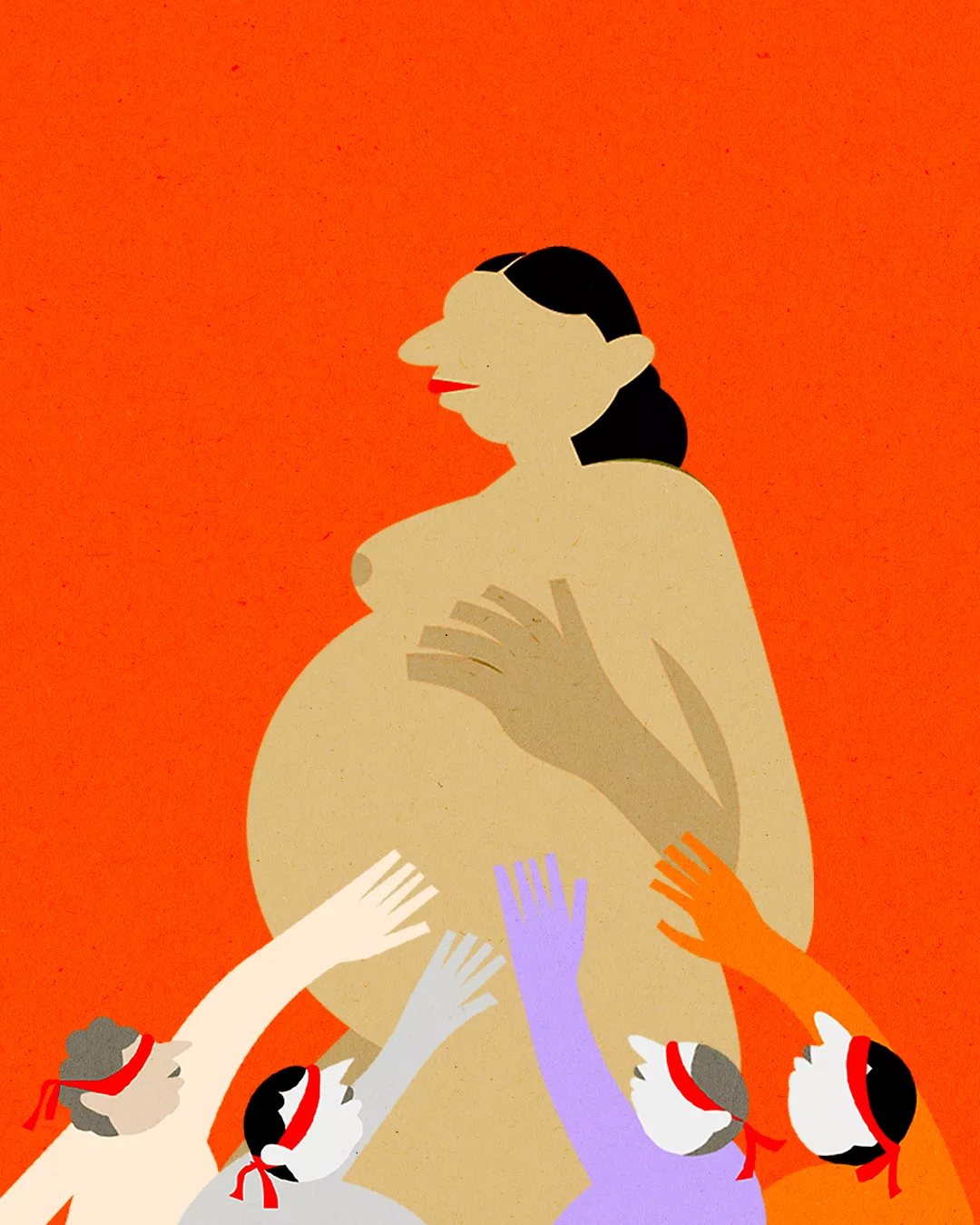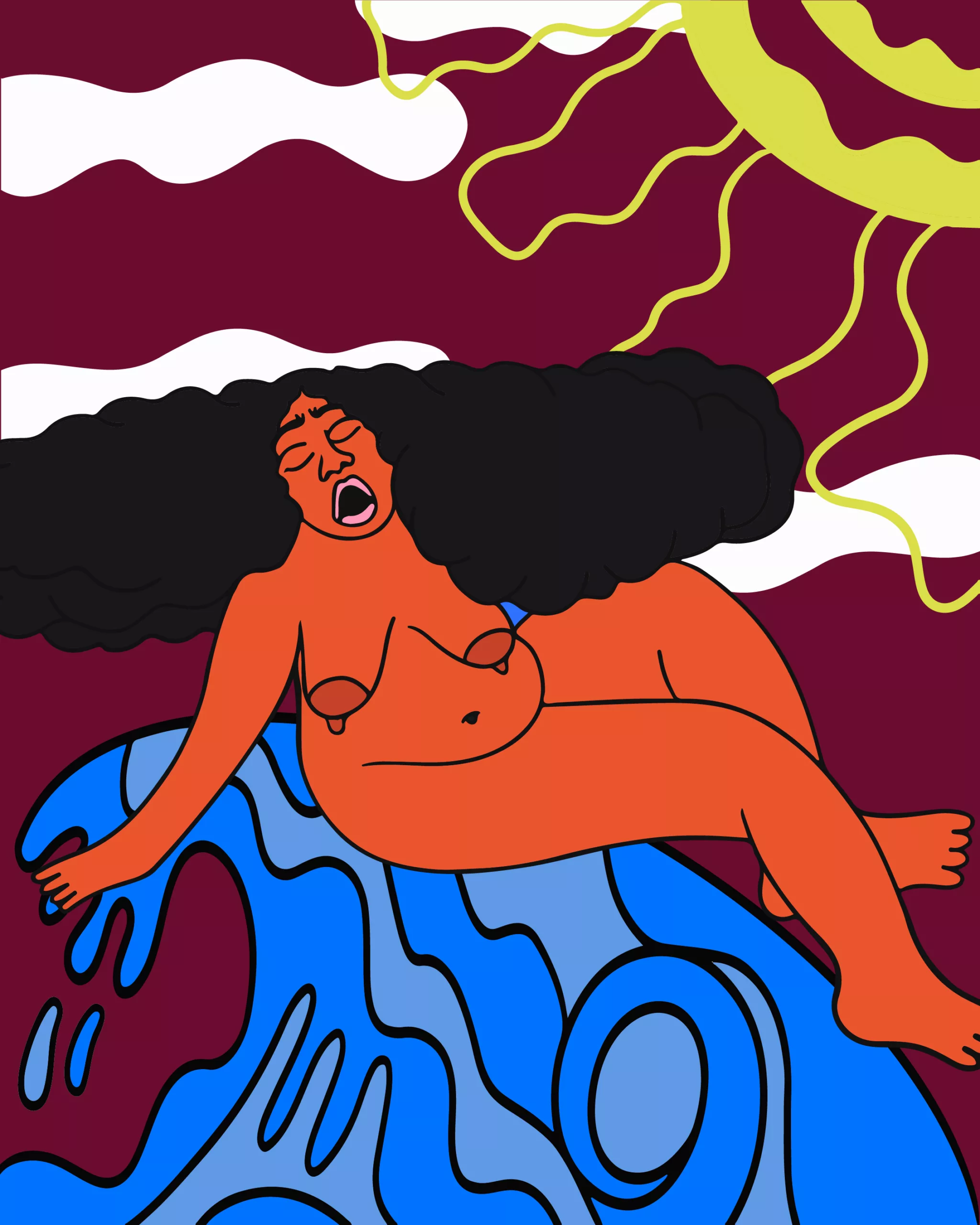Your cart is currently empty!

Getting Loose After “Too Much” Sex, and Five Other Myths About the Vulva and Vagina
Let’s face it: the vulva and vagina are taboo topics that are often left undiscussed in schools and underrepresented in popular culture and media. When we hear about them, it’s often in the form of jokes or pejorative comments: “close your legs, it smells like the ocean!” When we do see vulvas, it’s usually limited to pornography and medical textbooks, where they tend to look relatively uniform. It’s therefore unsurprising that so many of us are poorly informed about the vulva and vagina and that there are several myths about them still going around!
Here are six that are relatively common:
“Is vaginal discharge normal?”

In 2016, the “Panty Challenge,” which involved sharing pictures of one’s clean, spotless panties on social media, went viral on the internet. Its purpose? To proudly show people that one has no vaginal discharge. This kind of challenge stems from the social representation of the “ideal” and “healthy” vagina as being completely devoid of secretions 🙄.
The thing is, vaginal discharge is completely normal. Discharge is made up of several elements: secretions from the cervix and from glands located near the vaginal opening (Bartholin’s and Skene’s glands), substances produced by “good” bacteria, dead cells, and transudate (Gunter, 2019).
Also, it should be kept in mind that the amount, colour, and texture of discharge changes throughout the menstrual cycle due to hormonal fluctuations.
Normal vaginal discharge can be white, yellowish, or colourless, as well as sticky, watery, or like an egg white in texture. And it’s all good.
So if you see a whitish or yellowish spot in your panties during the day, you have nothing to be ashamed of or be worried about: you are normal, and your vagina is in good health.
On the other hand, although most causes of vaginal dryness are benign and temporary (for example, having had one drink too many, smoked weed, or taken certain medications such as antihistamines), others require a medical consultation. For example, persistent vaginal dryness or difficulty lubricating can be caused by an infection or by major hormonal changes (taking hormonal contraceptives that don’t contain estrogen, pregnancy, breastfeeding, menopause, etc.).
2. “My vulva isn’t symmetrical and my labia minora are much longer than my labia majora. Is that normal?”

From mainstream pornography to medical illustrations, vulvas tend to be represented as symmetrical and with labia minora that don’t extend past the labia majora. It’s therefore unsurprising that many people are dissatisfied with the appearance of their genitals or are ashamed of them, leading some to consider vulvovaginal cosmetic surgery (Smith et al., 2017). According to a U.S. study on women who underwent this type of surgery, 53% said they did so purely for aesthetic reasons, and 33% to improve their self-esteem (Goodman et al., 2010).
Regardless of people’s reasons, this type of surgery is not without risk: in 3 to 30% of cases, it leads to complications that can include infection, scarring, pain, bladder and bowel issues, and loss of genital sensation, and therefore, of sexual pleasure (Giarenis & Cardozo, 2014).
Yet, there’s a lot of diversity and variability in vulva size, colour, hairiness, and (a)symmetry!
No two vulvas are alike, and every vulva is fine (and normal) as it is. Because each vulva is unique, there is no standard.
Research shows that being exposed to images or videos that feature a diversity of unmodified vulvas is associated with better genital self-esteem (Fernando & Sharp, 2020; Laan et al., 2017). If you’re dissatisfied with the appearance of your vulva, I therefore warmly recommend The Labia Library, The Vulva Gallery or The Great Wall of Vagina to access beautiful collections of images of diverse vulvas 😊.
3. “If I have ‘too much’ penetrative sex, will my vagina get loose?”

If we applied the same logic to the penis, we’d think that it gets smaller and thinner with “too much” penetrative sex, much like a pencil shrinks in a pencil sharpener. Sorry (not sorry) for the image! 🤪
But, in all seriousness, the penis (like fingers or dildos) is neither big enough nor powerful enough to loosen the vagina, whether the vagina-haver in question has had penetrative sex once or a thousand times. This is due to the fact that the vagina—the muscular tube located between the vulva and the cervix—is relatively flexible and elastic. It’s made to be able to stretch and regain its shape.
It’s also good to know that vaginal size varies enormously from one person to another. According to a magnetic resonance imaging (MRI) study, the length of the first third of the vagina varies between 4.4 and 8.4 cm, while that of the last two thirds varies between 5.1 and 14.4 cm (Luo et al., 2016).
But that’s not all! Vaginal size also varies within the same person depending on where they are in their menstrual cycle, as well as on their level of sexual arousal. More specifically, the vagina tends to be longer during ovulation because the cervix rises and recedes slightly at this point in the menstrual cycle (Faust et al., 2019). Similarly, the uterus gradually rises a few centimetres during sexual arousal to reach maximum distension at orgasm (Schultz et al., 1999). This phenomenon is known as “vaginal tenting”.
The vagina is a real shapeshifter! So, if the inner two-thirds of the vagina seem loose during sexual activity, it simply means that the person is very aroused physically (and isn’t that what we want?).
So, “too much” sex loosens the vagina? Oh, please! Enough with the slut-shaming!
4. “Can you tell if a person is a virgin by examining their hymen?”

For a long time, it was believed that the hymen, a thin membrane at the opening of the vagina, could serve as an indicator of virginity. According to this belief, a person who has never experienced vaginal penetration would have an “intact” hymen, which would tear and bleed profusely during the first time they had vaginal intercourse.
However, this belief is not supported by science at all. For example, according to one study, almost half of people who have ever had vaginal sex have a hymen that could be considered “intact” (Adams et al., 2004). So what gives?
First, just like vulvas, the shape and size of hymens vary tremendously from person to person (Hegazy & Al-Rukban, 2012), regardless of sexual (in)experience. Furthermore, only about 0.1% of people born with a vulva have a completely closed hymen (Stelling et al., 2000), which requires medical intervention to allow vaginal discharge and menstrual flow to exit the body. At the other extreme, not everyone with a vulva even has a hymen 🤷.
Second, the hymen’s appearance also changes over a person’s lifetime (Hegazy & Al-Rukban, 2012). Before puberty, the hymen is thinner and more rigid, and therefore more likely to tear. In contrast, after an increase in estrogen during and after puberty, the hymen thickens and becomes more flexible and elastic. It therefore tends to be moved aside and stretched rather than torn during vaginal penetration (Hegazy & Al-Rukban, 2012), even when it’s the person’s very first time.
Moreover, since this membrane doesn’t contain many blood vessels, it doesn’t bleed as much as one would imagine when or if it does tear (Raveenthiran, 2009).
5. “Do I have to wash my vulva and vagina often? What products should I use?”

At the pharmacy, there’s no shortage of “hygiene” products to clean the vulva and vagina, to eliminate “bad smells” or “embarrassing odours” and to restore genital “freshness” (lol). Some are also labelled “organic,” “pH balanced,” or “tested/approved by gynecologists,” which can reassure the people who buy these products, or even encourage people to purchase them. Regardless, the message is clear: the vulva and vagina stink and their secretions are filthy.
First, healthy vulvas and vaginas have natural scents that vary from one person to another, and none are like roses, tropical fruits, or a gentle summer breeze. We’re talking about genitals, not an exotic breakfast on a honeymoon!
In addition, as mentioned at the beginning of this article, vaginal secretions are normal and are composed, among other things, of “good” bacteria. Most of these are lactobacilli, which are essential for good vaginal health, as they prevent the growth of “bad” bacteria and the invasion of other pathogens that can affect the vaginal ecosystem (Witkin & Linhares, 2016) .
Douching can disrupt this ecosystem by affecting vaginal pH and killing lactobacilli, and several studies show that it can cause bacterial vaginosis or pelvic inflammatory disease, or even increase a person’s likelihood of contracting a sexually transmitted infection (Chee et al., 2020; Gondwe et al., 2020; Nwadioha et al., 2011). Since many vaginal infections are accompanied by strong and unusual odours, this means that douching can actually increase unpleasant vaginal odours 🤔.
According to gynecologist Dr. Jen Gunter, the vagina is self-cleaning. She also states that, like the vagina, the vulva’s mucous membranes, which cover the labia minora and the vestibule (in short, everything hiding behind the labia majora), shouldn’t be washed with soap or other hygiene products, because these products are likely to cause irritation and inflammation (Gunter, 2019). Just water is enough! 💦
On the other hand, the groin, pubis, and perineum can be washed with soap without any problem.
6. “Do most people with vaginas orgasm through vaginal penetration?”

We idealize the “vaginal” orgasm—an orgasm reached through vaginal penetration without any additional stimulation to the vulva or the clitoris—probably because it’s represented everywhere, whether in magazines (Porter et al., 2017; Rogers, 2005), in romance novels (Cabrera & Ménard, 2013) or in pornography (Séguin et al., 2018). But these depictions are actually far from the sexual realities of most people with vaginas.
Ever since Freud coined the concept of the “vaginal” orgasm in the early 20th century (Freud & Brill, 1925), scientists have been deconstructing and discrediting it. Given that the clitoris has internal structures that surround the outer third of the vagina, all orgasms achieved during penetration involve at least some clitoral stimulation.
Although many people can achieve orgasm without any direct stimulation of the head of the clitoris, studies suggest that “vaginal” orgasms are rather uncommon. For example, in a meta-analysis of 33 studies conducted over an 80-year period, Elisabeth Lloyd (2006) found that only 25% of women achieve orgasm always or almost always through vaginal penetration. In a representative sample of the Swedish population, only 47% of women said that they had ever reached orgasm through vaginal penetration (Fugl-Meyer et al., 2006).
We have to accept the fact that clitoral stimulation is essential to achieving orgasm for a majority of people with vulvas (Kinsey et al., 1953; Lloyd, 2006; Prause et al., 2016). Since the clitoris and the penis have the same embryological origin, expecting people with clitorises to orgasm without clitoral stimulation is like expecting people with penises to climax without penile stimulation. It’s not impossible, but it can be quite the challenge!
-
Adams, J. A., Botash, A. S. et Kellogg, N. (2004). Differences in hymenal morphology between adolescent girls with and without a history of consensual sexual intercourse. Archives of Pediatrics & Adolescent Medicine, 158(3), 280-285. https://doi.org/10.1001/archpedi.158.3.280
Cabrera, C. et Ménard, A. D. (2013). “She exploded into a million pieces”: A qualitative and quantitative analysis of orgasms in contemporary romance novels. Sexuality & Culture, 17, 193-212. https://doi.org/10.1007/s12119-012-9147-0
Chee, W. J. Y., Chew, S. Y. et Than, L. T. L. (2020). Vaginal microbiota and the potential of Lactobacillus derivatives in maintaining vaginal health. Microbial Cell Factories, 19(1), 1-24. https://doi.org/10.1186/s12934-020-01464-4
Faust, L., Bradley, D., Landau, E., Noddin, K., Farland, L. V., Baron, A. et Wolfberg, A. (2019). Findings from a mobile application–based cohort are consistent with established knowledge of the menstrual cycle, fertile window, and conception. Fertility and Sterility, 112(3), 450-457. https://doi.org/10.1016/j.fertnstert.2019.05.008
Fernando, A. N. et Sharp, G. (2020). Genital self-image in adolescent girls: the effectiveness of a brief educational video. Body Image, 35, 75-83. https://doi.org/10.1016/j.bodyim.2020.08.007
Freud, S. et Brill, A. A. (1925). Three contributions to the theory of sex (No. 7). Nervous and Mental Disease Publishing Company.
Fugl-Meyer, K. S., Öberg, K., Lundberg, P. O., Lewin, B. et Fugl-Meyer, A. (2006). On orgasm, sexual techniques, and erotic perceptions in 18- to 74-year-old Swedish women. The Journal of Sexual Medicine, 3(1), 56-68. https://doi.org/10.1111/j.1743-6109.2005.00170.x
Giarenis, I. et Cardozo, L. (2014). Cosmetic genital surgery. Obstetrics, Gynaecology & Reproductive Medicine, 24(9), 286-288. https://doi.org/10.1016/j.ogrm.2014.06.003
Goodman, M. P., Placik, O. J., Benson III, R. H., Miklos, J. R., Moore, R. D., Jason, R. A., … et Gonzalez, F. (2010). A large multicenter outcome study of female genital plastic surgery. The Journal of Sexual Medicine, 7(4), 1565-1577. https://doi.org/10.1111/j.1743-6109.2009.01573.x
Gunter, J. (2019). La bible du vagin. FIRST.
Gondwe, T., Ness, R., Totten, P. A., Astete, S., Tang, G., Gold, M. A., … & Haggerty, C. L. (2020). Novel bacterial vaginosis-associated organisms mediate the relationship between vaginal douching and pelvic inflammatory disease. Sexually Transmitted Infections, 96(6), 439-444. http://dx.doi.org/10.1136/sextrans-2019-054191
Hegazy, A. A. et Al-Rukban, M. O. (2012). Hymen: facts and conceptions. The Health, 3(4), 109-115.
Kinsey, A. C., Pomeroy, W., Martin, C. et Gebhard, P. (1953). Sexual behavior in the human female. W. B. Saunders.
Laan, E., Martoredjo, D. K., Hesselink, S., Snijders, N. et van Lunsen, R. H. (2017). Young women’s genital self-image and effects of exposure to pictures of natural vulvas. Journal of Psychosomatic Obstetrics & Gynecology, 38(4), 249-255. https://doi.org/10.1080/0167482X.2016.1233172
Lloyd, E. A. (2006). The case of the female orgasm: Bias in the science of evolution. Harvard University Press.
Luo, J., Betschart, C., Ashton-Miller, J. A. et DeLancey, J. O. (2016). Quantitative analyses of variability in normal vaginal shape and dimension on MR images. International Urogynecology Journal, 27(7), 1087-1095. https://doi.org/10.1007/s00192-016-2949-0
Nwadioha, S., Egah, D., Banwat, E., Egesie, J. et Onwuezobe, I. (2011). Prevalence of bacterial vaginosis and its risk factors in HIV/AIDS patients with abnormal vaginal discharge. Asian Pacific Journal of Tropical Medicine, 4(2), 156-158. https://doi.org/10.1016/S1995-7645(11)60059-X
Porter, C. N., Douglas, N. et Collumbien, M. (2017). ‘Enhance her pleasure–and your grip strength’: Men’s Health magazine and pseudo-reciprocal pleasure. Culture, Health et Sexuality, 19(7), 738-751. https://doi.org/10.1080/13691058.2016.1258591
Prause, N., Kuang, L., Lee, P. et Miller, G. (2016). Clitorally stimulated orgasms are associated with better control of sexual desire, and not associated with depression or anxiety, compared with vaginally stimulated orgasms. The Journal of Sexual Medicine, 13(11), 1676-1685. https://doi.org/10.1016/j.jsxm.2016.08.014
Raveenthiran, V. (2009). Surgery of the hymen: from myth to modernisation. The Indian Journal of Surgery, 71(4), 224. https://doi.org/10.1007/s12262-009-0065-9
Rogers, A. (2005). Chaos to control: Men’s magazines and the mastering of intimacy. Men and Masculinities, 8(2), 175-194. https://doi.org/10.1177/1097184X04265319
Schultz, W. W., van Andel, P., Sabelis, I. et Mooyaart, E. (1999). Magnetic resonance imaging of male and female genitals during coitus and female sexual arousal. BMJ, 319(7225), 1596-1600. http://dx.doi.org/10.1136/bmj.319.7225.1596
Séguin, L. J., Rodrigue, C. et Lavigne, J. (2018). Consuming ecstasy: Representations of male and female orgasm in mainstream pornography. The Journal of Sex Research. 55(3), 348-356. http://dx.doi.org/10.1080/00224499.2017.1332152
Smith, N. K., Butler, S., Wagner, B., Collazo, E., Caltabiano, L. et Herbenick, D. (2017). Genital self-image and considerations of elective genital surgery. Journal of Sex & Marital Therapy, 43(2), 169-184. https://doi.org/10.1080/0092623X.2016.1141820
Stelling, J. R., Gray, M. R., Davis, A. J., Cowan, J. M. et Reindollar, R. H. (2000). Dominant transmission of imperforate hymen. Fertility and Sterility, 74(6), 1241-1244. https://doi.org/10.1016/S0015-0282(00)01599-5
Witkin, S. S., & Linhares, I. M. (2017). Why do lactobacilli dominate the human vaginal microbiota?. BJOG: An International Journal of Obstetrics & Gynaecology, 124(4), 606-611. https://doi.org/10.1111/1471-0528.14390






